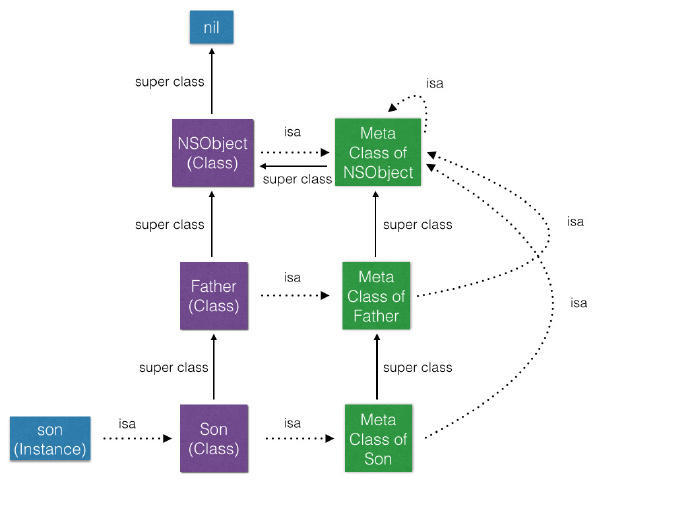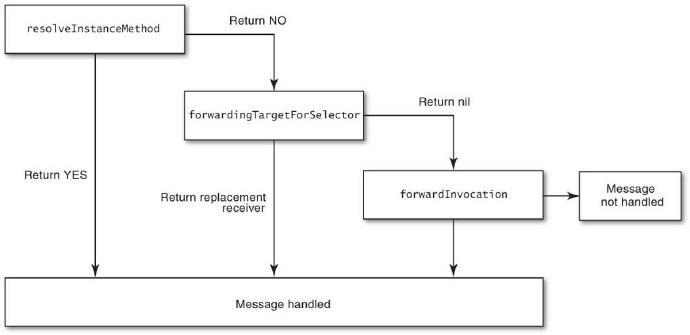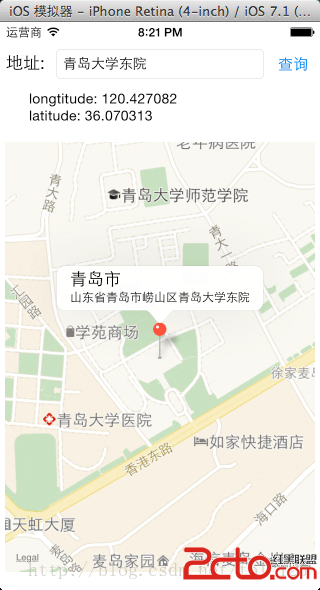iOS學習筆記38-MJExtension使用
一、MJExtension第三方框架
我們在iOS開發過程中,我們常常需要將字典數據(也就是JSON數據)與Model模型之間的轉化,例如網絡請求返回的微博數據、等等,如果我們自己全部手動去創建模型並賦值,都是一些毫無技術含量的代碼,費時費力,而且還可能會賦值出錯,讓我們很頭疼。
MJExtension框架就是為了解決這個問題而設計得第三方開源庫。這個開源庫是之前傳智博客的講師李明傑老師寫的,現在他自己出來做了,我iOS入門都是看李明傑老師的培訓視頻學習的,他講得非常好,我非常喜歡他,他也算是我的老師了,他的作品我還是要學習下的。
提供了以下的一些方法實現:
簡單的字典 –> 模型 JSON字符串 –> 模型 復雜的字典 –> 模型 (模型裡面包含了模型) 復雜的字典 –> 模型 (模型的數組屬性裡面又裝著模型) 復雜的字典 –> 模型(模型屬性名和字典的key不一樣) 字典數組 –> 模型數組 模型 –> 字典 模型數組 –> 字典數組 字典 –> CoreData模型 歸檔與解檔NSCoding 過濾字典的值MJExtension框架是利用Obj-C的運行時機制編寫的,現在iOS開發語言往Swift語言發展,我不太清楚Swift語言是否也有這種特性,該框架以後會不會在Swift語言上也發展下去不得而知,不過這個框架很輕量級,非常適合初級開發者去看它的源碼,對理解Obj-C的運行時機制有非常大的幫助。
二、Runtime運行時機制簡單了解
Runtime簡稱運行時,就是系統在運行的時候的一些機制,其中最主要的是消息機制。
OC的函數調用類似於消息發送,屬於動態調用過程。在編譯的時候並不能決定真正調用哪個函數。事實證明,在編譯階段,OC可以調用任何函數,即使這個函數並未實現,只要申明過就不會報錯。而C語言在編譯階段就會報錯。只有在真正運行的時候才會根據函數的名稱找到對應的函數來調用。
例如,下面的這個代碼在編譯時會被轉化:
/* OC方法調用 */
[obj makeTest];
/* 編譯時Runtime會將上面的代碼轉為下面的消息發送 */
objc_msgSend(obj, @selector(makeText));
iOS的頂層基類NSObject含有一個指向objc_class結構體的isa指針:
@interface NSObject{
Class isa;
};
typedef struct objc_class *Class;
struct objc_class {
Class isa; // 指向metaclass,也就是靜態的Class
Class super_class ; // 指向其父類
const char *name ; // 類名
long version ; // 類的版本信息,初始化默認為0
/* 一些標識信息,如CLS_CLASS(0x1L)表示該類為普通class;
CLS_META(0x2L)表示該類為metaclass */
long info;
long instance_size ; // 該類的實例變量大小(包括從父類繼承下來的實例變量);
struct objc_ivar_list *ivars; // 用於存儲每個成員變量的地址
/* 與info的一些標志位有關,如是普通class則存儲對象方法,如是metaclass則存儲類方法; */
struct objc_method_list **methodLists ;
struct objc_cache *cache; // 指向最近使用的方法的指針,用於提升效率;
struct objc_protocol_list *protocols; // 存儲該類遵守的協議
};

在objc_msgSend函數的調用過程:
首先通過obj的isa指針找到obj對應的Class。 在Class中先去cache中通過SEL查找對應函數method 若cache中未找到,再去methodLists中查找 若methodLists中未找到,則進入superClass按前面的步驟進行遞歸查找 若找到method,則將method加入到cache中,以方便下次查找,並通過method中的函數指針跳轉到對應的函數中去執行。 如果一直查找到NSObject還沒查找到,則會進入消息動態處理流程。
消息動態處理流程:
/* 1. 時機處理之一,在這個方法中我們可以利用runtime的特性動態添加方法來處理 */
+ (BOOL)resolveInstanceMethod:(SEL)sel;
/* 2. 時機處理之二,在這個方法中看代理能不能處理,如果代理對象能處理,則轉接給代理對象 */
- (id)forwardingTargetForSelector:(SEL)aSelector;
/* 3. 消息轉發之一,該方法返回方法簽名,如果返回nil,則轉發流程終止,拋出異常 */
- (NSMethodSignature *)methodSignatureForSelector:(SEL)aSelector;
/* 4. 消息轉發之二,在該方法中我們可以對調用方法進行重定向 */
- (void)forwardInvocation:(NSInvocation *)anInvocation;

所以使用Runtime機制我們就可以動態向類添加方法或屬性:
/* 動態向一個類添加屬性 */
class_addIvar(kclass, "expression", size, alignment, "*");
/* 動態向一個類添加方法 */
class_addMethod(kclass, @selector(setExpressionFormula:), (IMP)setExpressionFormula, "v@:@");
class_addMethod(kclass, @selector(getExpressionFormula), (IMP)getExpressionFormula, "@@:");
static void setExpressionFormula(id self, SEL cmd, id value){
NSLog(@"call setExpressionFormula");
}
static id getExpressionFormula(id self, SEL cmd){
NSLog(@"call getExpressionFormula");
return nil;
}
v表示void,@表示id類型,:表示SEL類型 "v@:@":表示返回值為void,接受一個id類型、一個SEL類型、一個id類型的方法 "@@:":表示返回值為id類型,接受一個id類型和一個SEL類型參數的方法
具體Runtime運行時使用細節,這裡就不細講,只是簡單了解下Runtime是可以做到動態向類添加屬性和方法就行。
三、MJExtension使用
MJExtension的大部分方法實現都集成到了分類上,不需要使用新的類,只需要包含頭文件MJExtension.h即可。MJExtension在github上的使用說明已經寫得十分明白了。
1. 簡單的字典 –> 模型
模型類User定義:
typedef enum {
SexMale,
SexFemale
} Sex;
@interface User : NSObject
@property (copy, nonatomic) NSString *name;/* 姓名 */
@property (copy, nonatomic) NSString *icon;/* 頭像 */
@property (assign, nonatomic) unsigned int age;/* 年齡 */
@property (copy, nonatomic) NSString *height;/* 身高 */
@property (strong, nonatomic) NSNumber *money;/* 資產 */
@property (assign, nonatomic) Sex sex;/* 性別 */
@property (assign, nonatomic, getter=isGay) BOOL gay;/* 是否是同性戀 */
@end
使用實例:
NSDictionary *dict = @{
@"name" : @"Jack",
@"icon" : @"lufy.png",
@"age" : @20,
@"height" : @"1.55",
@"money" : @100.9,
@"sex" : @(SexFemale),/* 枚舉需要使用NSNumber包裝 */
@"gay" : @"NO"
};
//字典轉模型,使用的是mj_objectWithKeyValues:方法
User *user = [User mj_objectWithKeyValues:dict];
2. JSON字符串 –> 模型
使用實例:
// 定義一個JSON字符串
NSString*jsonString = @"{\"name\":\"Jack\", \"icon\":\"lufy.png\", \"age\":20}";
// JSON字符串轉模型
User *user = [User mj_objectWithKeyValues:jsonString];
3. 復雜的字典 –> 模型 (模型裡面包含了模型)
模型類Status定義:
@interfaceStatus: NSObject
@property(copy, nonatomic) NSString*text;
@property(strong, nonatomic) User *user;/* 其他模型類型 */
@property(strong, nonatomic) Status *retweetedStatus;/* 自我模型類型 */
@end
使用實例:
NSDictionary *dict = @{
@"text" : @"Agree!Nice weather!",
@"user" : @{
@"name" : @"Jack",
@"icon" : @"lufy.png"
},
@"retweetedStatus" : @{
@"text" : @"Nice weather!",
@"user" : @{
@"name" : @"Rose",
@"icon" : @"nami.png"
}
}
};
//字典轉模型,模型裡面含有模型
Status *status = [Status mj_objectWithKeyValues:dict];
NSString *text = status.text;
NSString *name = status.user.name;
NSString *icon = status.user.icon;
NSLog(@"text=%@, name=%@, icon=%@", text, name, icon);
// text=Agree!Nice weather!, name=Jack, icon=lufy.png
NSString *text2 = status.retweetedStatus.text;
NSString *name2 = status.retweetedStatus.user.name;
NSString *icon2 = status.retweetedStatus.user.icon;
NSLog(@"text2=%@, name2=%@, icon2=%@", text2, name2, icon2);
// text2=Nice weather!, name2=Rose, icon2=nami.png
4. 復雜的字典 –> 模型 (模型的數組屬性裡面又裝著模型)
模型類Ad和StatusResult定義:
@interfaceAd: NSObject
@property(copy, nonatomic) NSString*image;
@property(copy, nonatomic) NSString*url;
@end
@interfaceStatusResult: NSObject
/** 數組中存儲模型Status類型數據 */
@property(strong, nonatomic) NSMutableArray*statuses;
/** 數組中存儲模型Ad類型數據 */
@property(strong, nonatomic) NSArray*ads;
@property(strong, nonatomic) NSNumber*totalNumber;
@end
#import "MJExtension.h"
/* 數組中存儲模型數據,需要說明數組中存儲的模型數據類型 */
@implementation StatusResult
/* 實現該方法,說明數組中存儲的模型數據類型 */
+ (NSDictionary *)mj_ objectClassInArray{
return@{ @"statuses": @"Status",
@"ads": @"Ad"
};
}
@end
使用實例:
NSDictionary *dict = @{
@"statuses" : @[
@{
@"text" : @"Nice weather!",
@"user" : @{
@"name" : @"Rose",
@"icon" : @"nami.png"
}
},
@{
@"text" : @"Go camping tomorrow!",
@"user" : @{
@"name" : @"Jack",
@"icon" : @"lufy.png"
}
}
],
@"ads" : @[
@{
@"image" : @"ad01.png",
@"url" : @"http://www.ad01.com"
},
@{
@"image" : @"ad02.png",
@"url" : @"http://www.ad02.com"
}
],
@"totalNumber" : @"2014"
};
//字典轉模型,支持模型的數組屬性裡面又裝著模型
StatusResult *result = [StatusResult mj_objectWithKeyValues:dict];
//打印博主信息
for (Status *status in result.statuses) {
NSString *text = status.text;
NSString *name = status.user.name;
NSString *icon = status.user.icon;
NSLog(@"text=%@, name=%@, icon=%@", text, name, icon);
}
// text=Nice weather!, name=Rose, icon=nami.png
// text=Go camping tomorrow!, name=Jack, icon=lufy.png
//打印廣告
for (Ad *ad in result.ads) {
NSLog(@"image=%@, url=%@", ad.image, ad.url);
}
// image=ad01.png, url=http://www.ad01.com
// image=ad02.png, url=http://www.ad02.com
5. 復雜的字典 –> 模型(模型屬性名和字典的key不一樣)
模型類Bag和Student定義:
@interface Bag : NSObject
@property (copy, nonatomic) NSString *name;
@property (assign, nonatomic) double price;
@end
@interface Student : NSObject
@property (copy, nonatomic) NSString *ID;
@property (copy, nonatomic) NSString *desc;
@property (copy, nonatomic) NSString *nowName;
@property (copy, nonatomic) NSString *oldName;
@property (copy, nonatomic) NSString *nameChangedTime;
@property (strong, nonatomic) Bag *bag;
@end
#import "MJExtension.h"
@implementation
/* 設置模型屬性名和字典key之間的映射關系 */
+ (NSDictionary *)mj_replacedKeyFromPropertyName{
/* 返回的字典,key為模型屬性名,value為轉化的字典的多級key */
return @{
@"ID" : @"id",
@"desc" : @"desciption",
@"oldName" : @"name.oldName",
@"nowName" : @"name.newName",
@"nameChangedTime" : @"name.info[1].nameChangedTime",
@"bag" : @"other.bag"
};
}
@end
使用實例:
NSDictionary *dict = @{
@"id" : @"20",
@"desciption" : @"kids",
@"name" : @{
@"newName" : @"lufy",
@"oldName" : @"kitty",
@"info" : @[
@"test-data",
@{
@"nameChangedTime" : @"2013-08"
}
]
},
@"other" : @{
@"bag" : @{
@"name" : @"a red bag",
@"price" : @100.7
}
}
};
//字典轉模型,支持多級映射
Student *stu = [Student mj_objectWithKeyValues:dict];
//打印
NSLog(@"ID=%@, desc=%@, oldName=%@, nowName=%@, nameChangedTime=%@",
stu.ID, stu.desc, stu.oldName, stu.nowName, stu.nameChangedTime);
// ID=20, desc=kids, oldName=kitty, nowName=lufy, nameChangedTime=2013-08
NSLog(@"bagName=%@, bagPrice=%f", stu.bag.name, stu.bag.price);
// bagName=a red bag, bagPrice=100.700000
6. 字典數組 –> 模型數組
使用實例:
NSArray *dictArray = @[
@{
@"name" : @"Jack",
@"icon" : @"lufy.png"
},
@{
@"name" : @"Rose",
@"icon" : @"nami.png"
}
];
//字典數組轉模型數組,使用的是mj_objectArrayWithKeyValuesArray:方法
NSArray *userArray = [User mj_objectArrayWithKeyValuesArray:dictArray];
//打印
for (User *user in userArray) {
NSLog(@"name=%@, icon=%@", user.name, user.icon);
}
// name=Jack, icon=lufy.png
// name=Rose, icon=nami.png
7. 模型 –> 字典
使用實例:
//創建一個模型對象
User *user = [[User alloc] init];
user.name = @"Jack";
user.icon = @"lufy.png";
Status *status = [[Status alloc] init];
status.user = user;
status.text = @"Nice mood!";
//模型轉字典,使用的是mj_keyValues屬性
NSDictionary*statusDict = status.mj_keyValues;
NSLog(@"%@", statusDict);
/*
{
text = "Nice mood!";
user = {
icon = "lufy.png";
name = Jack;
};
}
*/
8. 模型數組 –> 字典數組
使用實例:
//創建模型數組
User *user1 = [[User alloc] init];
user1.name = @"Jack";
user1.icon = @"lufy.png";
User *user2 = [[User alloc] init];
user2.name = @"Rose";
user2.icon = @"nami.png";
NSArray *userArray = @[user1, user2];
//模型數組轉字典數組,使用的是mj_keyValuesArrayWithObjectArray:方法
NSArray *dictArray = [User mj_keyValuesArrayWithObjectArray:userArray];
NSLog(@"%@", dictArray);
/*
(
{
icon = "lufy.png";
name = Jack;
},
{
icon = "nami.png";
name = Rose;
}
)
*/
9. 字典 –> CoreData模型
使用實例:
NSDictionary *dict = @{
@"name" : @"Jack",
@"icon" : @"lufy.png",
@"age" : @20,
@"height" : @1.55,
@"money" : @"100.9",
@"sex" : @(SexFemale),
@"gay" : @"true"
};
//字典轉為CoreData模型
NSManagedObjectContext *context = nil;
User *user = [User mj_objectWithKeyValues:dict
context:context];
[context save:nil];
10. 歸檔與解檔NSCoding
模型類Bag添加實現:
@interface Bag : NSObject
@property (copy, nonatomic) NSString *name;
@property (assign, nonatomic) double price;
@end
#import "MJExtension.h"
@implementation Bag
//添加了下面的宏定義
MJExtensionCodingImplementation
/* 實現下面的方法,說明哪些屬性不需要歸檔和解檔 */
+ (NSArray *)mj_ignoredCodingPropertyNames{
return @[@"name"];
}
@end
使用實例:
//創建模型
Bag *bag = [[Bag alloc] init];
bag.name = @"Red bag";
bag.price = 200.8;
//獲取歸檔路徑
NSString *file = [NSHomeDirectory() stringByAppendingPathComponent:@"Desktop/bag.data"];
//歸檔
[NSKeyedArchiver archiveRootObject:bag toFile:file];
//解檔
Bag *decodedBag = [NSKeyedUnarchiver unarchiveObjectWithFile:file];
NSLog(@"name=%@, price=%f", decodedBag.name, decodedBag.price);
// name=(null), price=200.800000
11. 過濾字典的值
模型類Book實現:
@interface Book: NSObject
@property (copy, nonatomic) NSString *name;
@property (strong, nonatomic) NSDate *publishedTime;
@end
#import "MJExtension.h"
@implementation Book
/* 轉化過程中對字典的值進行過濾和進一步轉化 */
- (id)mj_newValueFromOldValue:(id)oldValue property:(MJProperty *)property
{
if ([property.name isEqualToString:@"publisher"]) {
if (oldValue == nil) {
return @"";
}
} else if (property.type.typeClass == [NSDate class]) {
NSDateFormatter *fmt = [[NSDateFormatter alloc] init];
fmt.dateFormat = @"yyyy-MM-dd";
return [fmt dateFromString:oldValue];
}
return oldValue;
}
@end
使用實例:
NSDictionary *dict = @{
@"name" : @"5分鐘突破iOS開發",
@"publishedTime" : @"2011-09-10"
};
//字典轉模型,過濾name為nil的情況,把NSString轉為NSDate
Book *book = [Book mj_objectWithKeyValues:dict];
//打印
NSLog(@"name=%@, publishedTime=%@", book.name, book.publishedTime);
MJExtension的github地址點這裡:CoderMJLee/MJExtension




